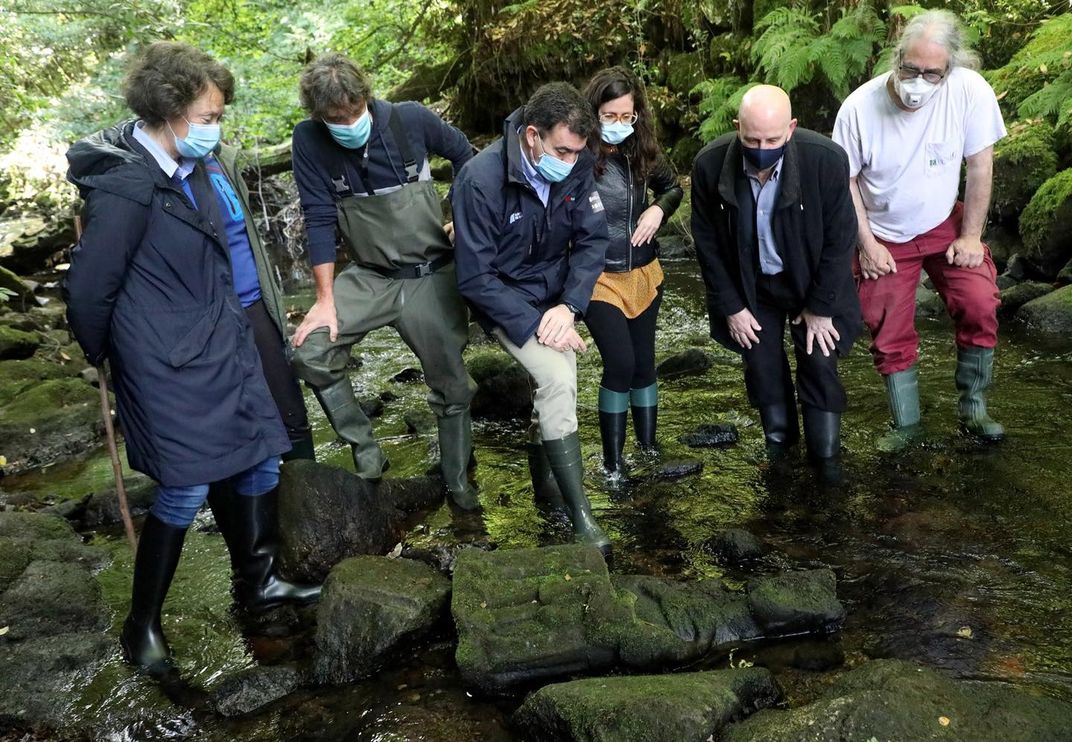Fisherman Finds Suspected Medieval Statue in Spanish Riverbed
Researchers think the religious icon, which depicts the Virgin Mary holding baby Jesus, is about 700 years old
/https://tf-cmsv2-smithsonianmag-media.s3.amazonaws.com/filer/ac/49/ac49a37c-e55b-4d03-9b21-5fccea6fd23b/700-year-old_gothic_statue_found_in_a_spanish_river.jpeg)
Earlier this month, a fisherman in Galicia, Spain, literally stumbled onto a rare discovery, reports Montse García for La Voz de Galicia.
Fernando Brey was fishing for trout in the Sar River, near the city of Santiago de Compostela, when he tripped on what appeared to be a stone.
“I noticed the stone was square, which is odd in a river, and then I looked at its lines, at the cape and at the shape of the head,” Brey tells La Voz de Galicia, as translated by the Guardian’s Sam Jones. “And I said to myself, ‘There’s something here.’”
Brey soon realized that this was no ordinary river rock, but rather a statue of some kind. He sent photos of the find to Ana Paula Castor, a member of local heritage association Apatrigal, and she identified it as a religious icon depicting the Virgin Mary and baby Jesus. An initial analysis by Castor and Galicia’s Ministry of Culture dated the statue to the 14th century, meaning it could be more than 700 years old.
Per an Apatrigal statement, the moss-covered religious icon is sculpted out of granite and weighs about 330 pounds. Designed in the Galician Gothic style, it portrays the enthroned Mary with her child resting on her lap.
Two worn angels sit on Mary’s shoulders, holding up her cape or a similar object on either side. The statue’s base is decorated with four-petaled flowers and acanthus leaves; its shape has led researchers to theorize that the statue was once attached to a wall, according to artnet News.
Officials say the sculpture may have once hung in a now-lost church and pilgrimage site in Conxo, a community close to where the statue was discovered. Conxo is situated on the outskirts of Santiago de Compostela, capital of Spain’s Galicia region and the home of its famed cathedral, which serves as the final destination on the Camino de Santiago pilgrimage trail.
Non todos os días podemos ser testemuñas da recuperación dun ben de gran valor patrimonial como a virxe que foi descuberta no río Sar ao seu paso por Conxo. Trátase dunha posible peza gótica que agora vai ser estudada e trasladada ao Museo das Peregrinacións e de Santiago pic.twitter.com/nNXm8nwo7L
— Román Rodríguez (@RomanLalin) June 15, 2020
Both Mary and Jesus are missing their faces, reports La Voz de Galicia. Someone may have removed these features in an attempt to desanctify the religious icon, according to a government statement.
Workers removed the statue from the riverbed on Monday and transported it to the Museum of Pilgrimage and Santiago for cleaning and further study, reports Fiona Govan for the Local Spain.
“Studies should tell us whether this is a very valuable gothic statue,” regional minister of culture Román Rodríguez said during a visit to the riverbed site, as reported by the Guardian. “But beyond its cultural and historic value, we’ll also need to try to put together the story of this statue: What happened, and how could it remain undiscovered so close to the city for so many centuries? It must be quite a story.”
/https://tf-cmsv2-smithsonianmag-media.s3.amazonaws.com/accounts/headshot/nora.png)
/https://tf-cmsv2-smithsonianmag-media.s3.amazonaws.com/filer/8d/14/8d143546-4079-4939-b694-29e3ad8a10fe/medieval_statue_of_virgin_mary_in_the_museum_of_pilgramage_santiago_de_compostela.jpg)

/https://tf-cmsv2-smithsonianmag-media.s3.amazonaws.com/filer/d6/be/d6be5ef8-51c3-4bbd-85eb-800316423f68/medieval_statue_of_virgin_mary_covered_in_moss_in_the_river_where_it_was_discovered.jpg)
/https://tf-cmsv2-smithsonianmag-media.s3.amazonaws.com/accounts/headshot/nora.png)